Footnotes on 4.3
Misconceptions about the golden ratio
It may seem that some people are a little overenthusiastic about the golden ratio.
The following are a few remarks from
Georg Markovsky,
Misconceptions about the Golden Ratio,
The College Mathematcis Journal 23 (1992) 2-19.
- In complicated buildings (like the pyramids, for example),
there appear many lengths. In most buildings many "natural" rectangles are visible.
Hence there may occur a ratio of lengths close to 1.6,
or a rectangle with side lengths close to 1.6, Whether such examples warrant
the claim that the golden ratio appears in them by intention can be argued.
- In the "St. Jerome " painting by Leonardo da Vinci, how convincing is the rectangle drawn?
Isn't it somewhat arbitrary?
- In the Partheon, depending on numbers given, the ratios computed differ slightly from the
golden ratio.
- For the UN building, the ratios range between 1.76 (if measured from street level)
or around 1.92 (when measured from river level).
- Fechner's experiment, which is mentioned on page 260 of our text,
is less convincing if you know that Fechner only had 10 rectangles to choose from,
with ratios between 1 and 2.5.
Would you be able to even recognize a "golden" rectangle
if it is presented with 1000 other rectangles?
What if people would prefer a ratio of 1.59 even over the golden ratio?
Would Fechner have noticed this?
- It would be so nice if the golden ratio would appear everywhere, but we cannot
let our wishes affect our perception.
- By the way---this to some extend also applies to the observation that many
plants have Fibonacci petal numbers. For instance, Danforth counted petals in daisies
[C.H. Danforth,
Notes on numerical variation in the daisy,
Botanical Gazette, 46 (1908) 349-356], and found that Fibonacci numbers appear
just more frequently than other numbers. For instance, 21 petals occurs 423 times, but
22 petals occurs still 370 times.
- However, Golden ratios and Fibonacci numbers in seedheads and pinecones seem confirmed
by research in Biology, since they seem to have an internal, biological reason, see also
Julie J. Rehmeyer,
Mathematical lives of Plants: Why plants grow in geometrically curious patterns,
Science News 172 (2007) 42-43.

